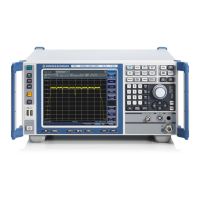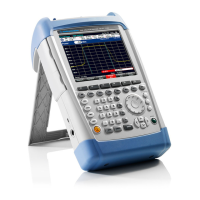Quick Start
R&S
®
FSVA/FSV
91Operating Manual 1176.7510.02 ─ 09
b) In the dialog box, enter 1 using the numeric keypad and confirm the entry by
pressing the MHZ key.
Note: Coupled settings. When the frequency span is defined, the resolution band-
width, the video bandwidth and the sweep time are automatically adjusted,
because these functions are defined as coupled functions in the presettings.
5. Measure the level and frequency using the marker by pressing the MKR key.
The marker is activated and automatically set on the maximum of the trace.
The level and frequency values measured by the marker are displayed in the
marker field at the top edge of the screen. They can be taken as the measurement
result.
M1[1] -30.00 dBm
128.00000 MHz
The field header indicates the number of the marker (Marker 1) and the trace on
which the marker is located ([1] = Trace 1).
Note: Performing a peak search. When a marker is initially activated, it automati-
cally performs the peak search function (as shown in the example).
If a marker was already active, you have to press the PEAK SEARCH key on the
front panel or the "Peak" softkey in the MKR > menu in order to set the currently
active marker to the maximum of the displayed signal.
Increasing the Frequency Resolution
The frequency resolution of the marker is predefined by the pixel resolution of the
trace. A trace uses 691 pixels, i.e. if the frequency span is 1 MHz, each pixel corre-
sponds to a span of approx. 1.4 kHz. This corresponds to a maximum uncertainty of +/-
0.7 kHz.
You can increase the pixel resolution of the trace by reducing the frequency span.
Reducing the frequency span to 10 kHz
1. Press the SPAN key.
2. Using the numeric keypad, enter 10 in the dialog box and confirm the entry with the
KHZ key.
The generator signal is measured using a span of 10 kHz. The pixel resolution of the
trace is now approx. 14 Hz (10 kHz span / 691 pixels) , i.e. the precision of the marker
frequency display increases to approx. ±7 Hz.
Setting the Reference Level
With signal analyzers, the reference level is the level at the upper limit of the diagram.
To achieve the widest dynamic range possible for a spectrum measurement, use the
entire level span of the signal analyzer. In other words, the highest level that occurs in
the signal should be located at the top edge of the diagram (=reference level) or imme-
diately below it.
Basic Measurement Examples

